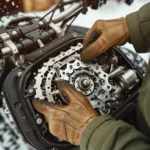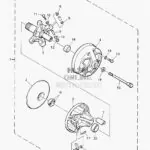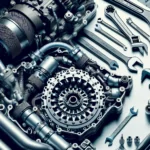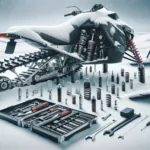Ready to take snowmobiling to the next level? Understanding how to correctly adjust your snowmobile’s clutch engagement can drastically improve your driving experience. This article is your perfect guide, elaborating on the proper techniques and tools needed for seamless clutch adjustment. You’ll be introduced to the step-by-step process, giving you control over your ride and subsequently propelling your snowmobiling skills forward. So, strap in, as your snowmobile is about to get a performance boost!
Understanding the Basics of Snowmobile Clutch Engagement
Having a fundamental understanding of snowmobile clutch engagement is essential for any snowmobile owner who is interested in keeping their machine running smoothly and efficiently. In a snowmobile, the clutch is a critical component that connects the engine to the drive train. Without it, your machine will not be able to function properly.
What is Snowmobile Clutch?
A snowmobile clutch is a mechanical part that aids in transmitting the power from the engine to the other parts of the snowmobile. This is done via a process of engagement and disengagement that help to control the speed, power and overall performance of your snowmobile.
Key Components of a Snowmobile Clutch
A snowmobile clutch is made up of various key components such as the primary and secondary clutch, the drive belt, and the sheave. The primary clutch is connected directly to the engine, and it’s this part that controls the power from the engine to the drivetrain. The secondary clutch, on the other hand, is connected to the tracks and looks after the speed given the power it receives.
Understanding Clutch Engagement in Snowmobiles
Clutch engagement in a snowmobile refers to the point at which the clutch begins to transmit power to the drivetrain. Once the RPMs reach a specific point, the clutch engages – this is what is known as the clutch engagement point. Over time, this clutch engagement point can change due to wear and tear, which may require adjustment to keep your snowmobile performing optimally.
Determining If Your Snowmobile Clutch Engagement Needs Adjustment
Just like any other mechanical equipment, a snowmobile clutch may need an adjustment if it is not functioning properly. Knowing when and how to adjust it is essential.
Common Signs Your Clutch May Need an Adjustment
If you notice a lack of response when accelerating, an unusual or heat smell, shuddering upon acceleration, or an unusual noise coming from your snowmobile, it’s likely that your clutch may need some adjustment.
Performing a Preliminary Clutch Inspection
Before adjusting your clutch, first perform a preliminary clutch inspection to ensure there aren’t any other issues at hand. Check for any worn, damaged, or missing parts. Look over the drive belt for any signs of wear or cracks. Pay attention to both the primary and secondary clutch to ensure they are able to move freely.
The Impact of an Improperly Adjusted Clutch
If your snowmobile clutch is improperly adjusted, it can have a significant impact on the performance of your machine. It can lead to excessive fuel consumption, a sluggish response in speed, and an overall decline in the performance of your snowmobile.
The Tools Required for Snowmobile Clutch Adjustment
Before you begin the clutch adjustment process, you’ll need to make sure you have the right tools at your disposal.
Basic Tool Requirements
For basic adjustments, a set of wrenches, a pry bar, and a rubber mallet will usually suffice. You might also need a torque wrench and a set of feeler gauges to ensure a precise adjustment.
Specialized Tools for Snowmobile Clutch Adjustment
For more advanced adjustments or to make the job easier, there are specialized tools available. These might include a clutch puller, clutch alignment tools, and belt tension tools.
Where to Purchase Necessary Tools
The tools mentioned can often be found at your local automotive store or you can purchase them from an online retailer. Keep in mind, investing in good quality tools can make the clutch adjustment process simpler and more efficient.
Preparation Steps Before Adjusting the Snowmobile Clutch Engagement
Before you start tinkering with your snowmobile, there are some practical steps you need to take.
Creating a Safe Work Environment
Turning off the engine and securing your snowmobile on a flat, stable working area is paramount. This not only creates a safe environment but also makes your work easier.
Dismounting the Snowmobile Clutch
To adjust the clutch, you will need to dismount it from the snowmobile. This is usually done by removing the drive belt and thereafter, detaching the clutch from its home on the crankshaft.
Inspecting the Clutch for Worn or Damaged Parts
Inspecting the clutch for worn or damaged parts is crucial. Damaged parts can affect the performance of the snowmobile and may even pose a safety hazard.
Adjusting the Primary Clutch Engagement
Before adjusting your snowmobile’s primary clutch, it’s important to understand what you’re dealing with.
Understanding the Primary Clutch
The primary clutch (also referred to as the drive clutch) is directly attached to the engine. It transmits power from the engine to the drivetrain. The primary clutch’s main function is to move in and out along the shaft in conjunction with engine speed.
Steps to Adjust Primary Clutch Engagement
To adjust primary clutch engagement, you’ll need to tweak the clutch spring. The clutch spring’s pre-load determines at what RPM the clutch will engage. A tighter spring increases RPM engagement while a looser spring lowers it.
Checking the Effectiveness of the Adjustment
After adjusting, it’s essential to check the effectiveness of your changes. Start your snowmobile and observe the changes in performance. If necessary, repeat the adjustment steps until you are satisfied.
Adjusting the Secondary Clutch Engagement
The secondary clutch plays an equally important role in the snowmobile’s overall performance.
Understanding the Secondary Clutch
The secondary clutch, also known as the driven clutch, is connected to the snowmobile’s track. The secondary clutch’s main purpose is to control the snowmobile’s speed given its received power.
Steps to Adjust Secondary Clutch Engagement
To adjust the secondary clutch engagement, you will need to adjust the helix, which controls how quickly the clutch shifts. A steeper helix angle means a quicker upshift, while a shallower angle allows for a slower upshift.
Ensuring the Primary and Secondary Clutch are in Harmony
Another critical aspect to remember is that the primary and secondary clutch must be synchronized to operate at their best. Misalignment can affect performance and can even cause permanent damage to your snowmobile.
Fine-Tuning the Clutch Engagement for Performance
The way you adjust your snowmobile clutch will also depend on your intention of use.
Understanding the Impact of Engagement on Performance
Higher engagement RPMs can increase your snowmobile’s power, but could also reduce the lifespan of your belt. On the other hand, lower engagement RPMs might result in less power but improved belt lifespan.
Advanced Adjustments for Racing or Heavy Duty Use
For racing or heavy-duty use, you might need an advanced adjustment. This might involve changing to a different type of clutch spring, adjusting the weight of the clutch, or even modifying the clutch’s components.
Professional Adjustment Services
In case the adjustments become too complex or you are unsure of something, it may be best to seek professional service. A clutch adjustment might seem simple, but a small mistake can lead to significant problems and even safety risks.
Routine Maintenance and Checks to Keep Clutch Engagement Optimal
Keeping your snowmobile in great shape involves more than just the occasional adjustment. Regular maintenance and checks are crucial.
How Often You Should Check Your Clutch Engagement
Ideally, you should check your clutch engagement after every 20 hours of use. Regular checks hold the key to your snowmobile’s peak performance and longevity.
Preventive Measures to Keep Your Clutch in Top Shape
Simple preventative measures like cleaning your clutch periodically, and ensuring that the cover and all components are securely fastened, can go a long way in keeping your snowmobile’s clutch in top shape.
The Role of Regular Servicing
Alongside DIY checks and adjustments, professional servicing plays a vital role in the upkeep of your snowmobile. Regular servicing includes comprehensive checks that can diagnose underlying issues you might have missed.
Solving Common Problems Related to Snowmobile Clutch Engagement
Several common issues can arise with snowmobile clutch engagement.
Addressing Issues of Clutch Slippage
Clutch slippage occurs when the drive belt fails to grip the clutch. This could be due to a worn-out drive belt or a clutch that needs adjustment.
Solving Problems of Inconsistent Engagement
Inconsistent engagement might result from worn-out clutch parts, misalignment, or improper adjustments. Regular check-ups can aid in diagnosing the issue.
Dealing with Clutch Overheating
Clutch overheating is another typical issue usually resulting from an excessively tight drive belt or an improperly tuned clutch. Regular inspection and adjustment can help mitigate this problem.
Safety Measures When Adjusting the Snowmobile Clutch Engagement
Adjusting your snowmobile’s clutch engagement isn’t without its risks. It’s important to prioritize safety.
Safety Gears Needed
While working on your snowmobile, ensure you have adequate safety gear such as gloves and safety goggles.
Importance of Following Manufacturer’s Instructions
Adhere to the manufacturer’s instructions on clutch adjustments, as they are designed for the specific model of your snowmobile.
Dangers of Improper Clutch Adjustment
An improperly adjusted clutch can not only lead to performance issues but also safety hazards. For instance, it can cause the clutch to shatter, putting you and your machine at risk.
In conclusion, being proactive with your snowmobile clutch engagement maintenance and adjustments can go a long way to enhance your machine’s performance and lifespan. Armed with the right knowledge, tools and safety measures, you can keep your snowmobile running smoothly.
- What Snowboard Bindings Should I Get? - January 23, 2024
- What Size Screws For Snowboard Bindings? - January 23, 2024
- How To Snowmobile On Water? - January 23, 2024









